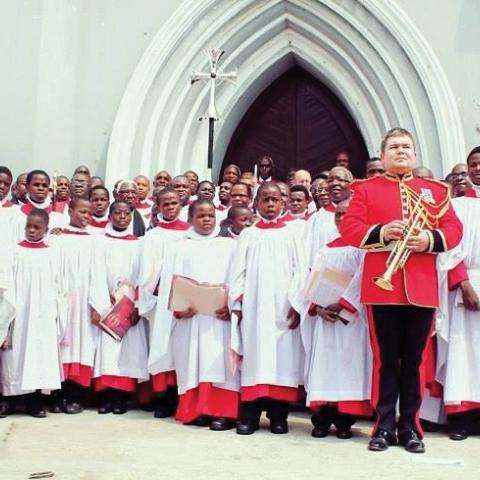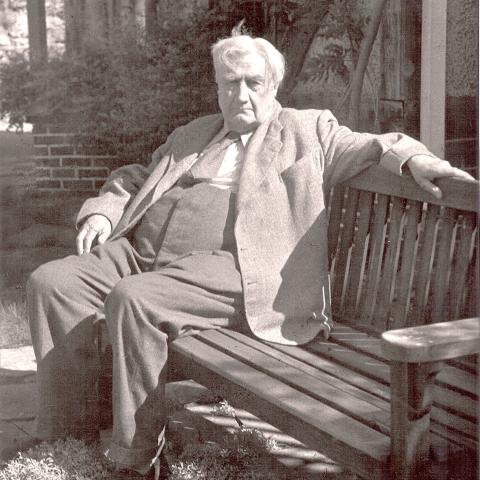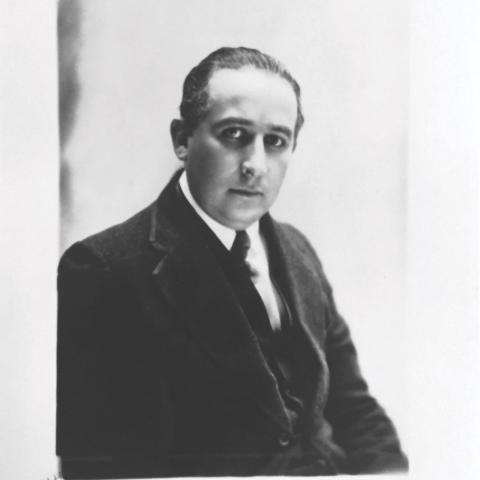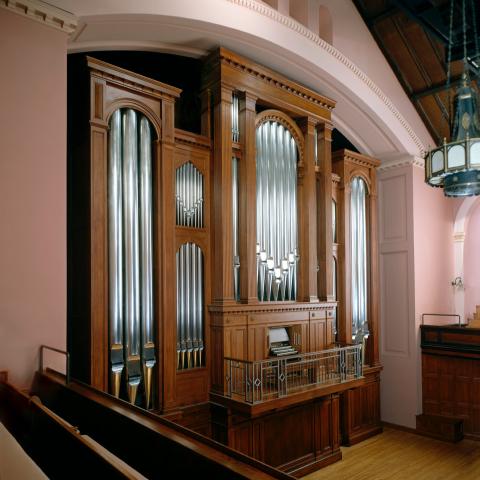Hereford Cathedral, UK
Lorraine Brugh is currently resident director of Valparaiso University’s Study Centre in Cambridge, England. She is professor of music and the Frederick J. Kruse Organ Fellow at Valparaiso University, Valparaiso, Indiana.

This festival existed before America was even invented,” exclaimed Roy Massey, organist emeritus of Hereford Cathedral and nine times conductor-in-chief of the Three Choirs Festival. We were standing beside the statue of Edward Elgar, in a corner of the cathedral gardens. For each festival at Hereford, Ruth Massey places a wreath of flowers around Elgar’s neck, and then stops by every day to water it. The Three Choirs Festival is an annual summer event shared between the Gloucester, Hereford, and Worcester cathedrals. Much like an American Guild of Organists national convention, it is a combination of choral and orchestral concerts, cathedral services, solo and chamber music recitals, masterclasses, talks, theatre, exhibitions, and walks, rotating each summer between the three beautiful English cathedral cities. It is the oldest non-competitive classical music festival in the world, having celebrated its 300th anniversary in 2015.
At the heart of the modern festival are the large-scale evening concerts featuring the Three Choirs Festival Chorus and the Philharmonia Orchestra, which has been resident at the festival since 2012. The Philharmonia is directed by Andrew Davis, who is also currently the music director and principal conductor of the Lyric Opera of Chicago. The festival’s packed schedule of daytime events is augmented by a community program that varies slightly in style in each city. This year there were seventy-six events: a combination of recitals, concerts, worship, family events, theater, and late-night jazz.
The origins of the annual music meetings of the three choirs of Gloucester, Worcester, and Hereford were outlined in 1729 in a sermon preached by Thomas Bisse, Chancellor of Hereford Cathedral. His three-centuries-old words still serve to describe the festival today. It sprang from:
. . . a very small and accidental origin. It was . . . a fortuitous and friendly proposal, between a few lovers of harmony and brethren of the correspondent choirs, to commence an anniversary visit, to be kept in turn; which voluntary instance of friendship and fraternity was quickly strengthened by social compact; and afterwards, being blessed and sanctioned by a charity collection, with the word of exhortation added to confirm the whole, it is arrived to the figure and estimation as ye see this day . . . .
Though the members of that communion we have entered into, being voluntary, may go off as their wills vary or as their affairs require, yet, by the accession of others, the Society may subsist unto many years, yea, generations, tendering to the furtherance of God’s glory, in the exaltation of His holy worship, to the improvement of our choirs, the credit of our foundations; to the benefit of our cities, the comfort of the fatherless; to the delight of mankind, of ourselves, and all that come nigh us. Upon these grounds it commenced, and upon these let our brotherly love continue.1
No one can attend all events, as there is some overlap of the schedule. There are varieties of interest, ranging from organbuilding to children’s crafts. All events are ticketed; some require purchase and others are free. One purchases tickets for the events one chooses over the eight-day period. While I attended only a small number of events, I found remarkably high professional quality throughout. Following is a listing of this year’s events I was able to attend.
Monday, July 30, 2018:
Elgar Society Lecture
The lecture room was filled to capacity with over a hundred people for this lecture by Roger Judd, “George Sinclair: A Man and His Dog.” Judd is the former assistant organist of St. George’s Chapel, Windsor. He investigated the friendship between Sir Edward Elgar and George Robertson Sinclair, Hereford Cathedral organist and music director during Elgar’s later years.
Mr. Judd began by imagining meeting George Sinclair and learning of his relation to Elgar and his history with the Three Choirs Festival. Born in 1863 in Croyden, Sinclair entered the Royal Academy of Music in Dublin at the age of eight. Sinclair spent six years at St. Michael’s College and Cathedral in Tenbury under the instruction of Arthur Frederick Ouseley. Ouseley was a composer, organist, musicologist, and priest and founded the cathedral school after visiting Leipzig and Dresden. He hoped the higher standards of those choirs would transfer to England. With John Stainer and Walter Parratt as well as George Sinclair as students there at the same time, the standards of church music were certainly raised.
At age sixteen Sinclair became assistant organist to Gloucester Cathedral, then became organist at the newly created Truro Cathedral at age eighteen. He was the mastermind in the design and acquisition of the 1887 Father Willis organ there. The organ at St. Michael’s in Tenbury had been rebuilt by Willis, so Sinclair was familiar with his work. Sinclair arranged all the musical celebrations of the dedication of the cathedral in 1887. He expected he would stay there his whole career.
However, just nine years after he arrived, he won the appointment as director of music at Hereford Cathedral in 1889. The appointment brought together the roles of performer, choirmaster, and orchestral conductor in one person. Curiously, no mention is made of involvement in the Three Choirs Festival in the position’s description.
Sinclair went about improving the quality of the music at Hereford, adding nine carols to the Christmas Eve services his first year. In 1891 he wrote to the cathedral chapter noting that the organ was below acceptable standards. With no financial assistance, he raised the entire amount of the renovation cost by playing a series of organ recitals. He commissioned Father Willis to carry out the restoration. The cathedral organ today is still very much the organ Willis had restored.
In 1887 Elgar made his first appearance as an audience member at the Three Choirs Festival. In 1889 Percy Hull became assistant to Sinclair. The three met and selected Elgar’s newly composed Te Deum to premiere at the 1889 festival. This, along with the appointment of young organists at both Gloucester and Worcester cathedrals, led to a revival of the Three Choirs Festival. The festival’s music changed greatly with Sinclair, adding orchestral music of Wagner, Beethoven, Schubert, Tchaikovsky, and Brahms.
From then on, Elgar was a frequent visitor to the Sinclair home. Sinclair was single his whole life and lived at the edge of the cathedral garden with his canine companion, Dan. In 1904 Elgar moved to Hereford and wrote some of his largest works. Sinclair received more single dedications from Elgar than anyone, including Pomp and Circumstance No. 4 and Enigma Variations. In 1904 Sinclair arranged a transcription of Pomp and Circumstance for organ.
Sinclair and Elgar became close friends, often cycling easily forty miles a day together. For Sinclair, work was sheer joy, whether at the festival or at the cathedral. On February 7, 1917, he was in Birmingham for a choral rehearsal. At his hotel that evening he died of heart failure.
His last festival was in 1912, as the festival was suspended during World War I, returning in 1920. At his funeral, the bishop remarked, “How he loved this church, his work, and his sympathy for the choir boys.”
Tenebrae
This eighteen-member professional London choir, directed by Nigel Short, a former King’s Singer, performed a program that challenged the choir and listeners alike. Following the festival’s World War I centenary theme, Short brought from the singers the widest array of sounds and emotions imaginable. From the relentless droning bass of John Tavener’s Song for Athene to the sound clusters of Judith Bingham’s A Walk with Ivor Gurney, the choir showed great precision, vocal maturity, and overall endurance. The two-hour program closed with Arnold Schoenberg’s Friede auf Erden/Peace on Earth, leaving the audience to ponder the challenge to “forge weapons that are harmless, flaming swords for righteousness.” It is certainly as much a challenge today as when he wrote it in 1907. The remainder of the program included music of Elgar, Ivor Gurney, Howells, and Parry. The choir handled the music of each composer as if it were their specialty, to enthusiastic acclaim.
Choral Evensong
The three cathedral choirs join forces each year in leading worship for the festival. This Evensong was a commemoration for three abolitionists, Thomas Clarkson, William Wilberforce, and Ottobah Cugoano, who championed the cause until the Slave Trade Act of 1807 was enacted.
Adrian Partington, director of music at Gloucester Cathedral, directed the combined choir, and Peter Dyke, assistant director of music at Hereford Cathedral, was organist. The choir sang responses by Hubert Sumsion, a psalm chant by Charles Stanford, canticles by Alan Gray, and an anthem by William Harris. It was a thoroughly British Evensong!
Tuesday, July 31: Olivier Latry
Celebrity Organ Recital
Olivier Latry’s recital was formidable in every way. From opening with J. S. Bach’s Prelude and Fugue in E-flat (the “St. Anne”) to closing with an improvisation on a submitted theme, Latry exuded technique and artistry at every turn. His clear, nearly flawless performance was aided by a light and versatile touch, clean articulation, and able rhythmic control. What mattered more to this listener was the expressive content he brought out of each piece, moving easily from one style to another. Clarity and rhythmic pulse organized Bach, while great rubato and overlapping legato enhanced Franck’s Choral in B Minor.
Latry exploited the colors of the organ in a transcription of Debussy’s Clair de Lune. The softest stops made the piece shimmer in the cathedral’s morning light. Dupre’s Prelude and Fugue in G Minor followed, filled with beautiful expression at breakneck speed. Latry rounded out the French repertoire with Alain’s subtle Postlude pour l’office des Complies and Thierry Escaich’s Evocation II. Latry then took the submitted theme and wound the program to a grand conclusion. After two bows and a cheering crowd, he returned to the organ to play a transcription of a Bach Brandenburg Concerto movement.
The only disaster of the morning came when Latry jumped up on to the orchestral stage for a final bow, missed a bit, and turned his ankle. One hoped for a speedy recovery as he was on deck that weekend at his home base at Notre Dame Cathedral in Paris.
Notes
1. Three Choirs Festival website: https://3choirs.org/about-us/history-of-the-three-choirs-festival/long-….
Photo credit: Michael Whitefoot






